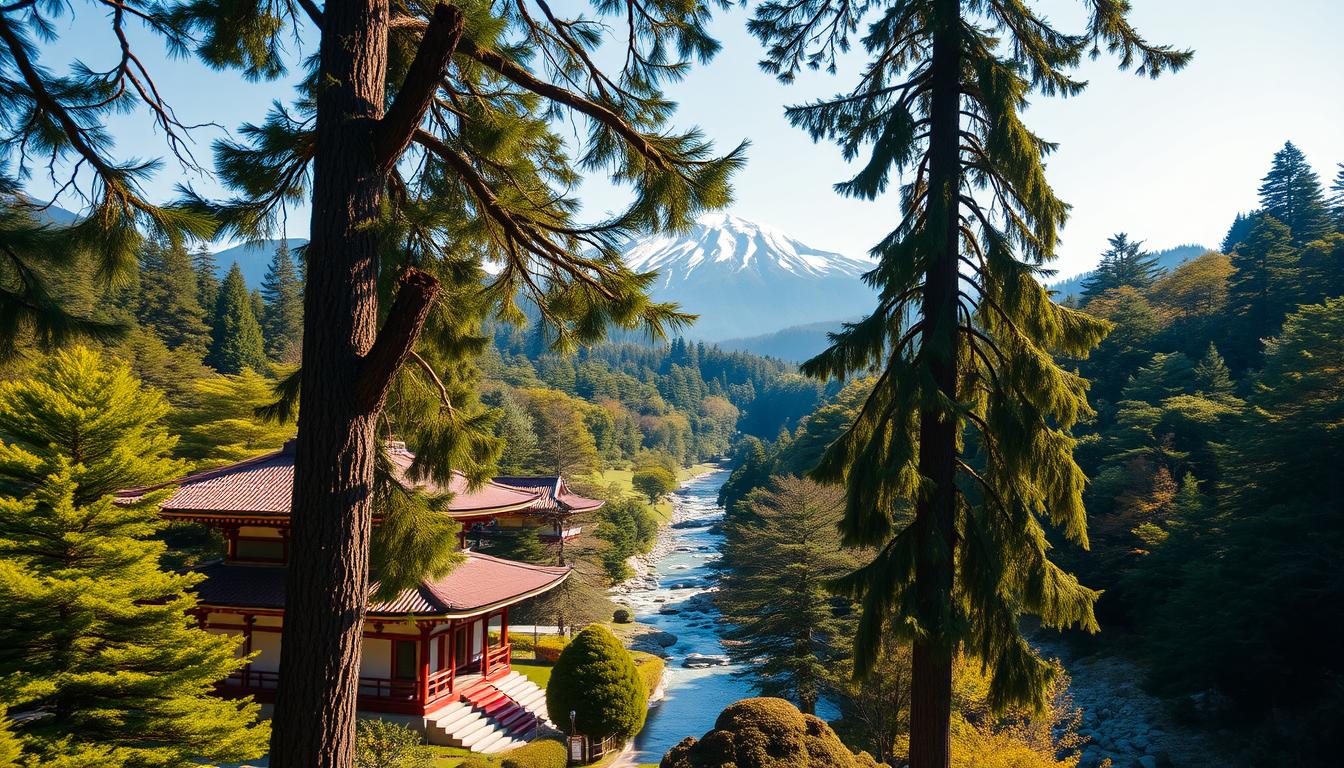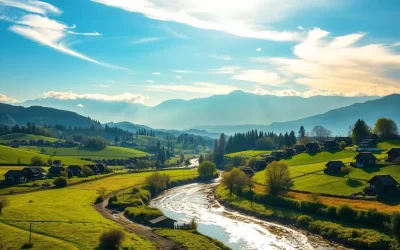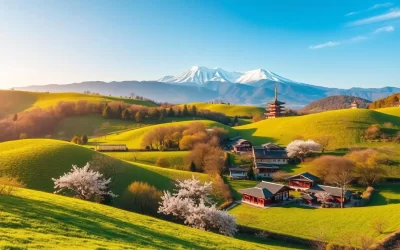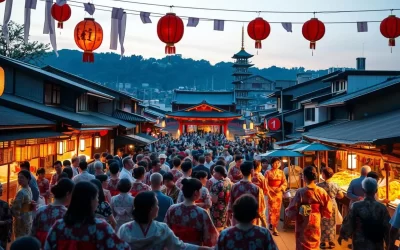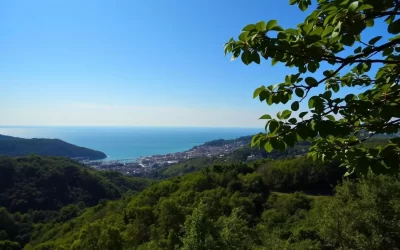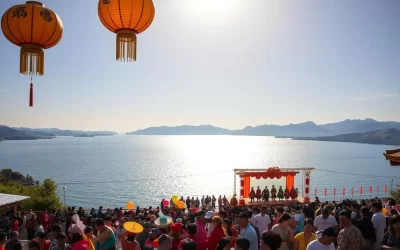Have you ever wondered what makes a destination truly unforgettable? Is it the breathtaking landscapes, the rich history, or the vibrant culture? In Nikko, you’ll find all of these elements seamlessly woven together, creating a place that leaves a lasting impression.
This article is your guide to discovering the best experiences in this remarkable location. From ancient shrines and temples to serene natural escapes, every recommendation is carefully curated to ensure your journey is nothing short of extraordinary. Whether you’re a history enthusiast, a nature lover, or a foodie, there’s something here for everyone.
Let’s dive into the heart of Nikko and uncover the treasures that make it a must-visit destination. With detailed insights and expert tips, you’ll be ready to embark on an adventure that combines culture, history, and natural beauty in one unforgettable trip.
Key Takeaways
- Discover a unique blend of culture and natural beauty in Nikko.
- Explore ancient shrines and temples with rich historical significance.
- Enjoy serene natural escapes, including waterfalls and scenic trails.
- Experience local cuisine that adds flavor to your journey.
- Get expert tips and firsthand insights for a seamless travel experience.
Introduction to the Enchanting World of Nikko
What if you could step into a world where history and nature collide in perfect harmony? In this serene escape, you’ll find vibrant shrines nestled among lush forests, creating a destination that feels both timeless and magical. Whether you’re seeking cultural immersion or natural beauty, this place offers an unforgettable blend of both.
What Makes This Place a Must-Visit Destination
This area is renowned for its rich cultural heritage and breathtaking landscapes. From ancient temples to cascading waterfalls, every corner tells a story. It’s no wonder it’s a UNESCO World Heritage Site, celebrated for its historical significance and natural wonders.
Getting here is easy, with convenient transport options from Tokyo. Whether you take a train or bus, the journey itself is part of the adventure, offering scenic views along the way.
Planning Your Unforgettable Adventure
To make the most of your trip, plan ahead. This ensures you don’t miss the hidden gems and iconic sites that make this destination so special. From serene walks through ancient forests to exploring vibrant shrines, every moment here is worth savoring.
In the following sections, we’ll guide you through everything you need to know. From historic temples to stunning natural landscapes, get ready for an adventure filled with tradition and beauty.
Nikko’s Rich Cultural Heritage and World Heritage Sites
What makes a place truly timeless? It’s the stories etched into its walls and the traditions that have stood the test of time. Here, you’ll find a treasure trove of cultural landmarks that have been preserved for centuries. From intricate carvings to grand architectural designs, every detail tells a story of a bygone era.
Historic Temples and Shrines
The area is home to some of the most well-preserved temples and shrines in the country. Among them, the Tosho-gu Shrine stands out as a masterpiece of the Tokugawa period. Its elaborate designs and vibrant colors are a testament to the craftsmanship of the era.
Another must-visit is the Rinno-ji Temple, a serene complex that dates back to the 8th century. Its tranquil atmosphere and stunning architecture make it a perfect spot for reflection and discovery.
UNESCO World Heritage Recognition
In 1999, the Shrines and Temples of Nikko were designated as a UNESCO World Heritage Site. This recognition highlights their global significance and the efforts to preserve their cultural and historical value. Walking through these sites, you’ll feel as though you’ve stepped back in time.
The intricate carvings and traditional artistry found here are unparalleled. Each shrine and temple offers a glimpse into the rich heritage that has shaped this region. Whether you’re a history buff or simply curious, these landmarks are sure to leave a lasting impression.
Must-See Landmark: Shinkyo Bridge
Have you ever stood before a structure that feels like a gateway to history? The Shinkyo Bridge is one of those rare landmarks that combines beauty, legend, and cultural significance. Spanning the Daiya River, this iconic structure is often referred to as the “Sacred Bridge” and is a must-visit for anyone exploring the area.
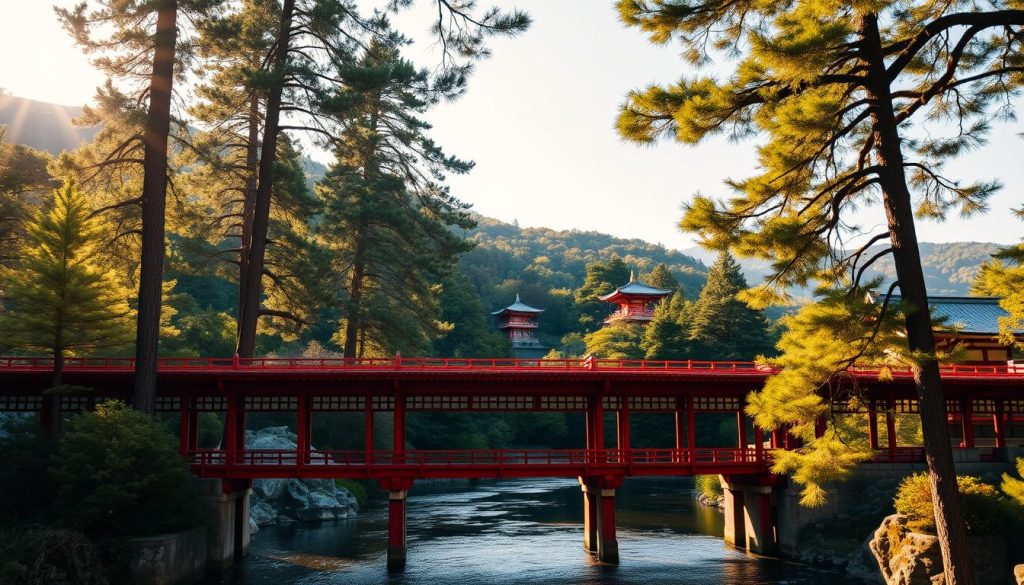
Historical Significance and Legends
Built in 1636, the Shinkyo Bridge has a rich history tied to the region’s spiritual heritage. According to legend, a 10-foot-tall god named Jinja-Daiou crossed the river on the backs of two snakes, inspiring the bridge’s creation. This story adds a layer of mystique to its already impressive design.
Originally reserved for important officials, the bridge was opened to the public in 1973. Its vibrant red color and traditional architecture make it a standout feature, blending seamlessly with the surrounding natural beauty.
Visiting Tips and Best Time to See It
To fully appreciate the Shinkyo Bridge, plan your visit during daylight hours for the best view. The bridge is equally stunning at night when illuminated, offering a different yet equally captivating experience. Admission is ¥500 for adults, making it an affordable addition to your itinerary.
Here’s a quick guide to help you plan your visit:
| Details | Information |
|---|---|
| Admission Fee | ¥500 (adults), ¥300 (high school students), ¥200 (elementary/junior high) |
| Best Time to Visit | Daytime for clear views, nighttime for illumination |
| Location | Daiya River, near Futarasan Shrine |
Whether you’re a history enthusiast or simply looking for a picturesque spot, the Shinkyo Bridge offers an unforgettable experience. Take your time to soak in the views and appreciate the craftsmanship that has stood the test of time.
Exploring Iconic Temples and Shrines
Ever wondered where history and artistry meet in perfect harmony? The sacred sites here are a treasure trove of cultural and spiritual significance. Each shrine and temple tells a story, blending religious art with centuries-old traditions.
Nikko Toshogu Shrine Highlights
The Toshogu Shrine is a masterpiece of the Edo period, known for its opulent decorations and intricate carvings. The Yomeimon Gate, often called the “Gate of the Setting Sun,” is a stunning example of craftsmanship. Its golden details and vibrant colors are a sight to behold.
This shrine is the resting place of Tokugawa Ieyasu, the first Shogun of the Edo period. The recent renovations, costing ¥40 billion, have restored its grandeur. Admission is ¥1300, offering access to a world of historical and artistic treasure.
Other Sacred Sites to Discover
Beyond the Toshogu Shrine, there are lesser-known gems worth exploring. The Rinno-ji Temple, with its gilded statues, offers a serene atmosphere. The Taiyuin Mausoleum, though less crowded, is equally captivating with its detailed architecture.
To avoid crowds, visit early in the morning or during weekdays. This allows you to fully appreciate the peaceful ambiance and intricate designs. Each site offers a unique glimpse into the region’s rich cultural heritage.
Nikko, Japan: Best Things to Do – Top Picks
Looking for a destination that offers a mix of history, nature, and culture? This place has it all. From ancient shrines to stunning waterfalls, every corner is filled with unique experiences waiting to be discovered. Here’s a curated list of the top picks to help you plan your adventure.
This list is carefully selected from a wealth of attractions, ensuring you don’t miss the highlights. Whether you’re a history buff, nature lover, or foodie, there’s something here for everyone. Use this as your checklist to make the most of your trip.
- Explore ancient shrines and temples: Dive into the rich cultural heritage with sites like the Toshogu Shrine and Rinno-ji Temple.
- Discover natural wonders: From Kegon Falls to Lake Chuzenji, the landscapes here are breathtaking.
- Experience local traditions: Stay at a ryokan and immerse yourself in authentic Japanese hospitality.
- Enjoy outdoor adventures: Hike scenic trails or take in panoramic views from the Akechidaira Ropeway.
- Savor local cuisine: Try Yuba, Soba, and Tochigi Wagyu for a taste of the region.
Each of these top picks offers a unique way to experience the beauty and culture of this destination. Whether you’re planning a short trip or an extended stay, these activities ensure your journey is unforgettable. Stay tuned as we dive deeper into each of these highlights in the upcoming sections.
Natural Wonders: Lakes, Waterfalls, and Scenic Vistas
What if you could witness nature’s grandeur in its purest form? This region is a paradise for those who love the outdoors. From cascading waterfalls to serene lakes, every corner offers a breathtaking view that feels like a masterpiece.
Kegon Falls and Chuzenji Lake Exploration
One of the most iconic sights here is Kegon Falls. With a 97-meter drop, it’s a stunning display of nature’s power. The falls are especially mesmerizing in winter when the water freezes into a phenomenon known as “Blue Ice.”
To get the best view, take the elevator down to the observation deck. It’s a small fee, but the experience is worth every penny. The surrounding area is lush and vibrant, making it a perfect spot for photos.
Just a short distance away lies Chuzenji Lake. This serene body of water adds to the region’s charm. Whether you’re boating or simply enjoying the view, the lake offers a peaceful escape from the hustle and bustle.
Akechidaira Ropeway Observation Deck Views
For a panoramic perspective, hop on the Akechidaira Ropeway. This short ride takes you to an observation deck that offers unbeatable views of the surrounding landscape. On a clear day, you can see Kegon Falls and Chuzenji Lake in all their glory.
The ropeway operates year-round, but each season brings a unique charm. In autumn, the foliage creates a colorful tapestry, while winter offers a snowy wonderland. Here’s a quick guide to help you plan your visit:
| Details | Information |
|---|---|
| Operating Hours | 9:00 AM – 4:30 PM (varies by season) |
| Ticket Price | ¥730 (adults), ¥370 (children) |
| Best Time to Visit | Morning for clear views, sunset for dramatic lighting |
Whether you’re a nature enthusiast or simply looking for a peaceful retreat, these natural wonders offer something for everyone. Plan your visit to experience the beauty of this region in every season.
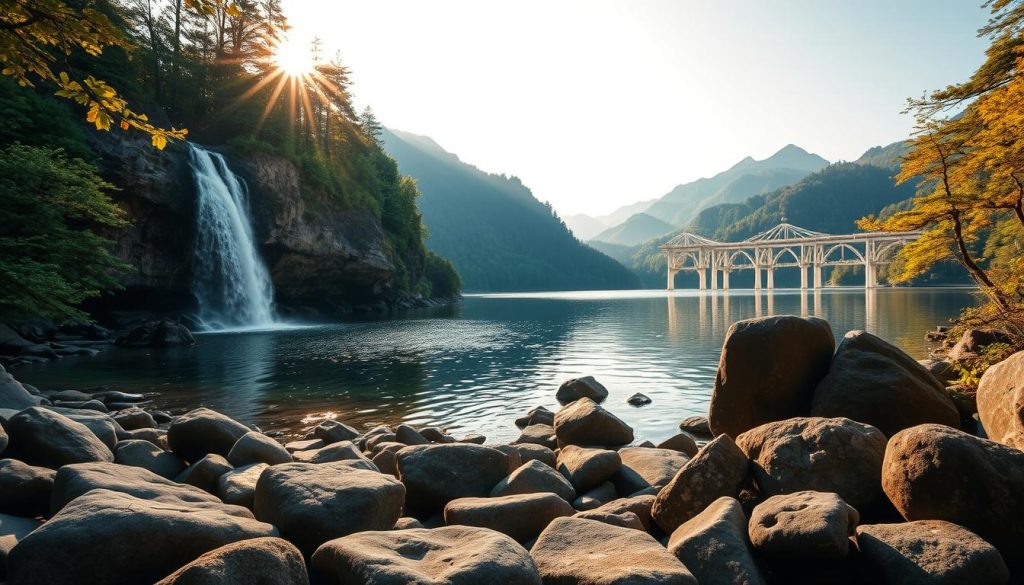
Hidden Gems: Kanmangafuchi Abyss and Takino’o Shrine
Ever dreamt of finding a peaceful escape away from the crowds? In this region, you’ll discover two serene spots that offer solitude and stunning natural beauty. These hidden treasures are perfect for quiet reflection and capturing unforgettable moments.
Secluded Nature Walks and Photo Opportunities
The Kanmangafuchi Abyss is a tranquil retreat open 24/7 with no entrance fee. This picturesque gorge is lined with moss-covered rocks and a row of stone statues known as the “Bake Jizo.” The gentle sound of the river and the lush surroundings create a calming atmosphere, ideal for a leisurely walk.
For photography enthusiasts, the Abyss offers countless sights to capture. The interplay of light and shadow through the trees adds a magical touch to your shots. Early mornings or late afternoons are the best times to visit for soft, natural lighting.
Another hidden gem is the Takino’o Shrine, a 1.5 km hike from the main tourist areas. This remote shrine is nestled in a dense forest, offering a sense of seclusion and spiritual connection. The trail itself is a delight, with towering trees and the occasional glimpse of wildlife.
Here are some tips to make the most of your visit:
- Wear comfortable shoes for the hike to Takino’o Shrine.
- Bring a camera or smartphone to capture the serene landscapes.
- Visit during weekdays to avoid any potential crowds.
These hidden gems provide a refreshing counterbalance to the more famous attractions. Whether you’re seeking solitude or a unique photo opportunity, these spots are sure to leave a lasting impression.
Traditional Experiences: Staying at a Ryokan
Imagine immersing yourself in a world where tradition meets tranquility. Staying at a ryokan offers a unique opportunity to experience authentic Japanese hospitality. These traditional inns are more than just a place to sleep; they are a gateway to cultural immersion.
Embracing Authentic Japanese Hospitality
A ryokan is a traditional Japanese inn that dates back centuries. Known for their tatami-matted rooms and communal baths, they provide a serene escape from the modern world. The experience begins the moment you step inside, greeted with a warm welcome and a cup of tea.
One of the highlights of staying at a ryokan is the onsen experience. These natural hot springs are perfect for relaxation, offering both indoor and outdoor baths. Many ryokans, like the Turtle Inn Nikko, also feature private onsen for a more intimate experience.
Here’s what you can expect during your stay:
- Tatami-matted rooms: Sleep on futons laid out on traditional straw mats.
- Kaiseki meals: Enjoy multi-course dinners featuring local and seasonal ingredients.
- Yukata robes: Wear these comfortable garments during your stay.
For those seeking a blend of tradition and luxury, the Nikko Akarinoyado Villa Revage is an excellent choice. This villa combines modern amenities with classic Japanese design, offering a peaceful retreat surrounded by lush gardens.
“Staying at a ryokan is like stepping back in time, where every detail is designed to make you feel at home.”
To make the most of your experience, book in advance. These sought-after accommodations often fill up quickly, especially during peak travel seasons. Whether you’re exploring the historic town or relaxing in your room, a stay at a ryokan is an unforgettable part of your journey.
| Ryokan | Unique Features |
|---|---|
| Turtle Inn Nikko | Private onsen, traditional tatami rooms |
| Nikko Akarinoyado Villa Revage | Luxury amenities, serene garden views |
Outdoor Adventures: Hiking and Biking Trails
Ready to explore the great outdoors with breathtaking trails and panoramic views? This region offers a variety of hiking and biking paths that cater to all skill levels. Whether you’re a seasoned adventurer or a casual explorer, there’s a trail waiting for you.
Hiking to Mt. Hangetsu Observation Deck
One of the most rewarding hikes is the trail to the Mt. Hangetsu Observation Deck. This moderate hike takes about two hours and offers stunning views of Chuzenji Lake and the surrounding mountains. The trail is well-marked, making it accessible for most hikers.
At the summit, you’ll be greeted with a panoramic observation point that’s perfect for photos. The serene atmosphere and the sense of accomplishment make this hike a must-do. Don’t forget to bring water, wear sturdy shoes, and check the weather before you start.
Additional Trails for the Active Traveler
For those seeking more challenges, the Senjogahara Plateau Trail is a 15 km trek that takes about 2.5 hours. This trail is especially beautiful in October when the autumn colors are at their peak. Another option is the Choishi-michi Trail, a 24 km journey that offers a mix of history and nature.
Here are some tips to make the most of your outdoor adventure:
- Start early to avoid crowds and enjoy cooler temperatures.
- Carry a map or use a GPS app for navigation.
- Pack essentials like water, snacks, and a first-aid kit.
These trails provide a unique way to experience the natural beauty of this region up close. Whether you’re hiking or biking, you’ll find plenty of opportunities to connect with nature and create unforgettable memories.
Seasonal Splendor: Autumn Foliage and Winter Wonders
Have you ever marveled at the beauty of nature’s seasonal transformations? This region offers a stunning display of colors and festivities that change with the year. From vibrant autumn leaves to snowy winter landscapes, every season brings its own magic.
Fall Colors and Scenic Drives
In autumn, the forests and temples are blanketed in shades of red, orange, and yellow. One of the best ways to experience this is by taking a scenic road trip. The winding paths offer breathtaking views of the foliage, making it a photographer’s paradise.
Popular spots include the Kegon Waterfall, where the cascading water is framed by vibrant leaves. Another must-see is the Senjogahara Plateau, known for its panoramic views. Plan your visit between October and early November for the peak colors.
Winter Festivals and Snow Activities
When winter arrives, the region transforms into a snowy wonderland. Festivals like the Sapporo Snow Festival feature enchanting ice sculptures. For outdoor enthusiasts, skiing and snowboarding at Niseko are top activities.
Don’t miss the chance to relax in a traditional onsen surrounded by snow. The crisp, refreshing air adds to the charm of the season. Here’s a quick guide to help you plan your winter visit:
| Details | Information |
|---|---|
| Best Time to Visit | December to February |
| Top Activities | Snow festivals, skiing, onsen |
| Must-See Spots | Kegon Waterfall, Niseko Ski Resort |
Whether you’re drawn to the fiery hues of autumn or the serene beauty of winter, this destination offers unforgettable experiences. Plan your trip to witness the seasonal splendor that makes this place truly special.
Savoring Nikko’s Local Cuisine
Ever wondered what flavors define a region’s soul? In this area, the culinary scene is a delightful blend of tradition and innovation. From delicate tofu skin to hearty soba noodles, every dish tells a story of the land and its people.
Delicious Yuba, Soba, and Tochigi Wagyu
One of the must-try specialties here is yuba, a delicate tofu skin that’s both creamy and light. Often served in soups or as part of a multi-course meal, it’s a testament to the region’s creativity. Another highlight is the soba noodles, handcrafted with precision and served with a flavorful dipping sauce.
For meat lovers, Tochigi Wagyu is a treat not to be missed. This prized beef is known for its marbling and melt-in-your-mouth texture. Whether grilled or served as part of a hot pot, it’s a culinary experience that’s hard to forget.
Where to Eat Like a Local
To truly savor these flavors, head to authentic eateries that locals frequent. Small, family-run restaurants often serve the best versions of these dishes. Look for places that specialize in one thing, like a soba shop or a yuba-focused café.
Here are some insider tips for dining like a local:
- Visit during off-peak hours to avoid crowds.
- Ask for recommendations from your ryokan or hotel staff.
- Try seasonal specialties for a fresh and unique experience.
Exploring the local cuisine is more than just a meal—it’s a way to connect with the culture and history of this region. So, take your time, savor every bite, and let the flavors tell their story.
Unique Attractions: Theme Parks and Edo Wonderland
Ever wanted to step back in time and experience life in a different era? In this region, you’ll find attractions that transport you to the past, offering a blend of history and entertainment. These venues are perfect for families and cultural enthusiasts alike, providing a unique way to explore Japan’s rich heritage.
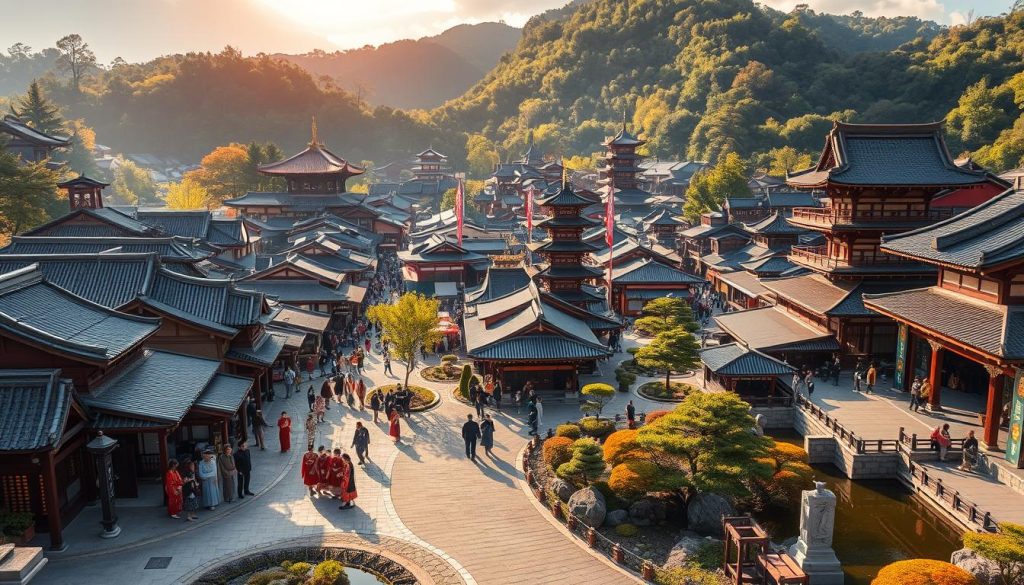
Experiencing Edo Period Culture
One of the most iconic attractions is Edo Wonderland, a theme park that recreates the Edo period (1603-1868). Here, you can immerse yourself in the daily life of samurai, ninjas, and merchants. The park is divided into five distinct areas, each offering a glimpse into different aspects of Edo-era Japan.
Interactive experiences like samurai training and ninja shows bring history to life. You can also watch traditional performances and participate in workshops, such as the Senbei Baking Experience. These activities provide a hands-on way to connect with the past.
Family-Friendly Attractions and Entertainment
For families, Edo Wonderland offers a variety of fun activities. Kids can dress up in period costumes and explore the park’s themed areas. The Oiran Dochu parade, held once daily, is a highlight that showcases the grandeur of the Edo period.
Here are some tips to make the most of your visit:
- Arrive early to enjoy the park’s attractions without the crowds.
- Check the schedule for performances and parades to plan your day.
- Take advantage of the free shuttle buses from JR Nikko Station for easy access.
These attractions offer a playful yet educational way to explore Japan’s history. Whether you’re a history buff or just looking for a fun day out, these venues are sure to leave a lasting impression.
Exploring Nikko’s Surrounding Areas and Scenic Roads
Have you ever wanted to escape the crowds and discover hidden gems? Beyond the main attractions, this region offers winding roads and tranquil areas that are perfect for exploration. These lesser-known spots provide a peaceful complement to the bustling town center.
One of the most picturesque drives is the Irohazaka Winding Road. This route connects the city to the mountainous region of Oku-Nikko and is especially stunning in autumn. The vibrant foliage creates a colorful backdrop, making it a favorite for photographers and nature lovers.
For a quieter experience, venture into the rural areas surrounding the town. Small villages like Shiobara offer a glimpse into traditional life. Here, you’ll find charming farms, local eateries, and serene walking paths. It’s a great way to slow down and enjoy the simple pleasures of the countryside.
If you’re looking for breathtaking views, head to the Akechidaira Plateau. This spot offers panoramic vistas of Lake Chuzenji, Kegon Falls, and the surrounding mountains. The observation deck is easily accessible and provides a perfect photo opportunity.
Here are some tips for exploring these scenic roads and areas:
- Plan your trip during weekdays to avoid crowds.
- Bring a map or GPS, as some routes can be winding and remote.
- Take your time to stop at viewpoints and soak in the natural beauty.
These surrounding areas offer a refreshing escape from the more popular attractions. Whether you’re driving along winding roads or exploring quiet villages, you’ll find plenty of hidden gems to make your trip unforgettable.
| Attraction | Highlights |
|---|---|
| Irohazaka Winding Road | Scenic drive, autumn foliage |
| Shiobara Village | Traditional charm, rural walks |
| Akechidaira Plateau | Panoramic views, photo opportunities |
Set aside extra time to explore these off-the-beaten-path adventures. They’ll add depth and tranquility to your journey, making it truly memorable.
Getting Around Nikko: Transportation and Passes
Navigating a new destination can be both exciting and overwhelming, but with the right tips, it becomes effortless. This area offers a variety of transportation options, from trains to buses, making it easy to explore its rich cultural and natural attractions. With a little planning, you can optimize your journey and make the most of your time here.
Bus and Train Travel Tips
One of the most convenient ways to get around is by using the local bus network. Buses run frequently, connecting major train stations to popular sites. For example, the World Heritage Sightseeing Bus is a great option for visiting shrines and temples. Trains are another reliable choice, with routes that link this area to nearby towns and attractions.
To avoid crowds, consider traveling during off-peak hours. Early mornings or late afternoons are ideal for a more relaxed experience. Planning your route in advance ensures you don’t miss key stops and saves time.
Optimizing Your Journey with Local Passes
Using local passes can save you both money and hassle. The World Heritage Area Pass, valid for two days, covers train travel from Tokyo and unlimited bus use within the core sightseeing area. For extended stays, the All Area Pass offers four days of unlimited travel on buses and trains.
Here’s a quick comparison of the passes:
| Pass | Validity | Cost |
|---|---|---|
| World Heritage Area Pass | 2 days | ¥2,040 (adults) |
| All Area Pass | 4 days | ¥4,600 (adults) |
These passes are available at major stations and tourist centers. They’re a smart investment for anyone looking to explore extensively without worrying about individual ticket costs.
With these tips and passes, getting around becomes a seamless part of your adventure. Whether you’re hopping on a bus or boarding a train, you’ll find it easy to reach every corner of this beautiful region.
Insider Tips for a Seamless Nikko Adventure
Want to unlock the secrets to a smooth and enriching trip? With a little insider knowledge, you can make the most of your time in this stunning destination. From avoiding crowds to discovering hidden gems, these tips will help you explore with confidence.
Local Secrets and Best Times to Visit
One of the best ways to enjoy your trip is by timing your visits strategically. Early mornings or late afternoons are ideal for popular spots like the Toshogu Shrine and Kegon Falls. These times offer fewer crowds and better lighting for photos.
For a quieter experience, explore lesser-known areas like the Kanmangafuchi Abyss or Takino’o Shrine. These hidden gems provide a peaceful escape and unique photo opportunities. Weekdays are also a great way to avoid the weekend rush.
“The best adventures often come from stepping off the beaten path and discovering what others might miss.”
Practical Advice for a Stress-Free Trip
Packing smart is key to a comfortable journey. Bring layers, as the weather can change quickly, especially in mountainous areas. Comfortable shoes are a must for exploring temples and hiking trails.
Understanding local etiquette can also enhance your experience. For example, bowing is a common greeting, and removing shoes is required when entering traditional spaces like ryokans or certain temples.
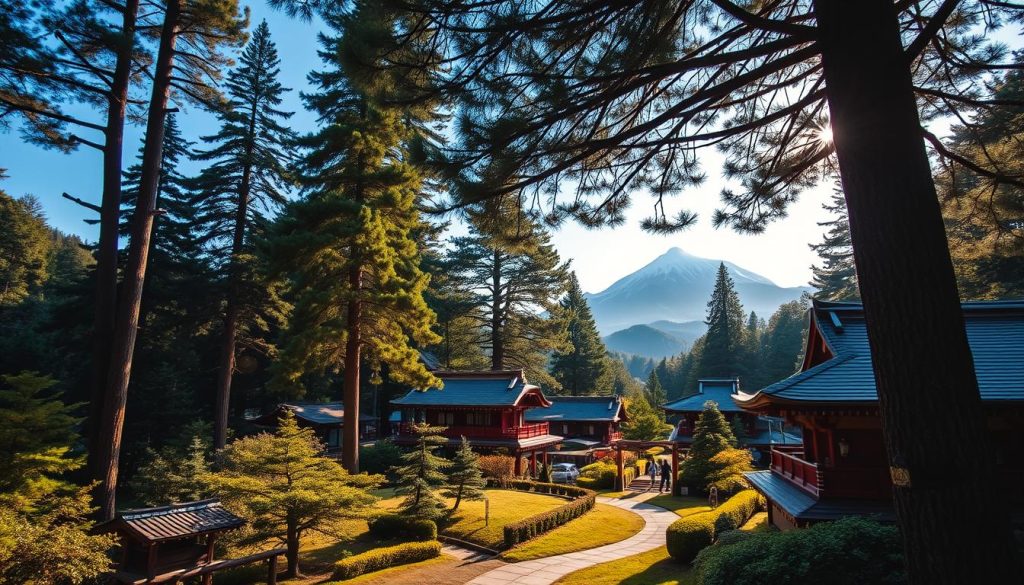
Navigating Peak Times and Hidden Alternatives
To avoid crowds, plan your visit during off-peak seasons like late spring or early autumn. These periods offer pleasant weather and vibrant scenery without the heavy tourist traffic.
Here’s a quick guide to help you plan:
| Attraction | Best Time to Visit |
|---|---|
| Toshogu Shrine | Early morning or late afternoon |
| Kegon Falls | Weekdays, early morning |
| Kanmangafuchi Abyss | Any time, less crowded |
With these tips, you’ll be well-prepared to explore this destination in a way that’s both enjoyable and authentic. Whether you’re uncovering hidden spots or navigating peak times, these insights will help you make the most of your adventure.
Conclusion
Ready to uncover a destination where culture, history, and nature intertwine? From serene temples to breathtaking waterfalls, this place offers a beauty that’s hard to match. Whether you’re drawn to historic sites, scenic trails, or traditional cuisine, there’s a thing here for everyone.
Throughout this guide, you’ve discovered insider tips and must-see spots that make planning your trip seamless. From the vibrant colors of autumn to the tranquility of hidden gems, every moment here is worth savoring.
Now is the perfect time to start planning your journey. Experience the unmatched beauty and rich heritage of Nikko for yourself. Your adventure awaits—create memories that will last a lifetime.
The above is subject to change.
Check back often to TRAVEL.COM for the latest travel tips and deals.
Here are some Tours & Sightseeing suggestions that might pique your interests!
